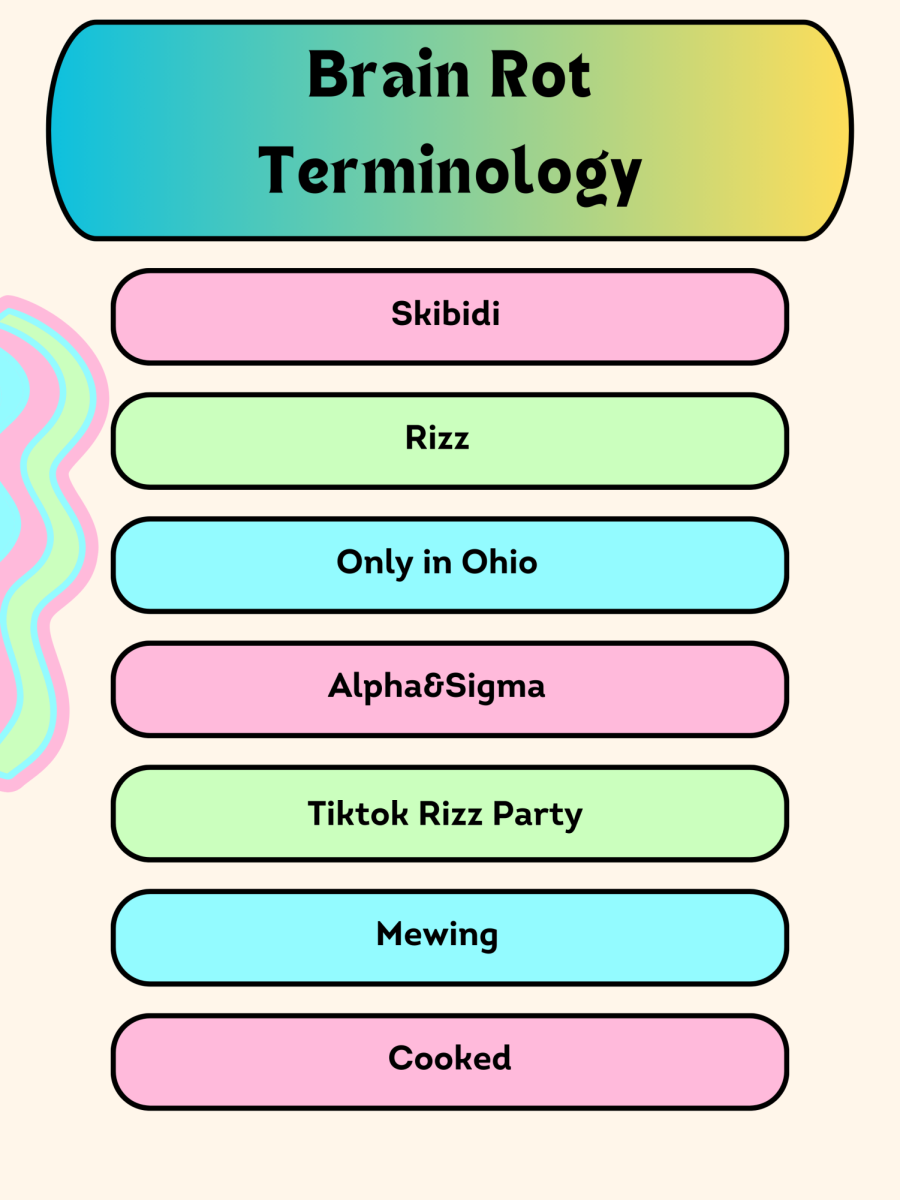From split-screen videos that pair random attention-grabbing videos like Subway Surfers or an “oddly satisfying” video of slime with completely unrelated main content, to parody songs packed with internet jargon like “rizz” and “sigma,” brain rot pervades social media.
First coined online as early as 2007, the term “brain rot” describes the cognitive decline caused by compulsive social media scrolling — a behavior often referred to as “doom scrolling.” This condition develops when users mindlessly consume vast amounts of meaningless content that require little to no thought. After prolonged exposure to such content, individuals often experience mind fogginess, struggling to absorb a flood of information.
The content that triggers this effect is known as brain rot, which has become a trend in itself. Despite lacking substance and informational value, this type of content has caught the attention of children and teens. As brain rot becomes increasingly popular among youth, it underscores the alarming trend of social media addiction and excessive screen time among Generation Z and, specifically, Generation Alpha, a generation growing up in an environment inundated by social media and unlimited access to digital platforms.
Sharing the same characteristics that make gambling on slot machines addictive, it is no surprise that rapidly scrolling through videos on social media is highly addictive. In 2022, TikTok videos lasting 21 to 34 seconds long proved to be the most engaging. If the average user were to have 1 and ½ hours of screen time per day and watch videos of that length, they could consume roughly 159 to 257 videos a day. Resembling TikTok’s short-form, fast-paced style, Instagram released “Reels” and Youtube launched “Shorts,” further contributing to the cycle of constant engagement and instant gratification.
Reels, YouTube Shorts, and TikTok are created to be addictive, revolving around the feature of the endless scroll. One after the other, there is a constant stream of algorithm-based recommendations for short, entertaining videos that are catered to match users’ interests. As each of the videos recommended are personalized to align with their preferences, users are encouraged to stay on the platform for as long as possible and lose track of time.

As the time spent rapidly scrolling through short-form videos increases, our attention spans decrease. By producing an endless stream of bite-sized videos that deliver instant entertainment in as little as 15 seconds, it is easy to binge-watch countless videos and lose track of time. This cycle triggers the brain’s reward system, which is driven by the release of dopamine — a neurotransmitter associated with the feeling of pleasure that motivates cravings for something enjoyable, like petting a cat, taking a drug or watching a funny TikTok video.
Once our brains produce dopamine after watching something entertaining, they feel motivated to find more of that pleasant sensation. Repeating the cycle of scrolling mindlessly through social media trains your brain to crave the dopamine produced from constant stimulation through short videos, resulting in an addiction to social media. The more we scroll, the more our brain craves the bursts of gratification experienced from watching short, entertaining videos, causing us to be more impatient and restless when we are forced to engage in longer assignments or activities.
“The idea of being able to persist when you have assignments that may be more challenging is really going to require you to give it more close, direct attention and time. If we’re used to those quick, immediate results [from short videos on social media], then sometimes we get used to that in life, in general, and in school,” said Mrs. Jennifer LaSure, a psychology teacher at Cherry Hill High School East.
With its algorithm that constantly adapts to each user’s preferences, TikTok and other short-form video platforms have the power to relieve boredom virtually in an instant. However, this increases our dependence on these platforms by decreasing our ability to entertain ourselves without the apps. Consequently, constant exposure to short content leaves children and teenagers struggling to focus on time-consuming tasks like reading, studying and holding conversations.
“Everything on TikTok has to be a minute… so it trains the brain to limit your attention span. So then what happens if you have to watch a video that is 10 minutes or even five minutes long? Our brains have become conditioned to that one minute, just like a muscle becomes conditioned when you work that muscle,” says Mrs. LaSure.
In response to these challenges, East implemented a new cell phone policy, which restricts cell phone use during instructional periods.
While the restriction of cell phone use can feel constricting, it is a necessary step in addressing the overwhelming influence of social media on our lives. With phones out of reach during instructional periods, students are encouraged to talk to one another and focus on learning free of mobile distractions.
“People are talking more to each other; they’re actually interacting instead of going on their phones,” said Señora Rachel Eister, a Spanish teacher at East, describing the immediate changes she has noticed in her classroom since the policy was introduced.
Although some students may initially find it difficult to adjust to the new policy, the long-term benefits of the cell phone policy must be recognized. Without the constant distraction of notifications and temptation to check their phone, students will be able to regain their concentration, which social media has conditioned to be shorter, causing us to be less patient and have shorter attention spans.
As social media’s reach on younger generations grows, the introduction of East’s new cell phone policy is a direct response to the issue of attention span deficiency and social media addiction. By reducing distractions from our phones, the new policy will be beneficial in helping students regain focus and improve concentration in school.


